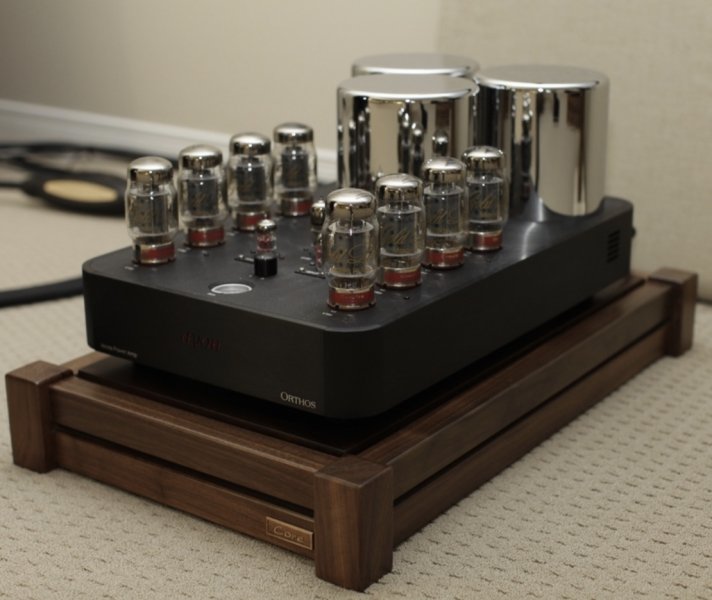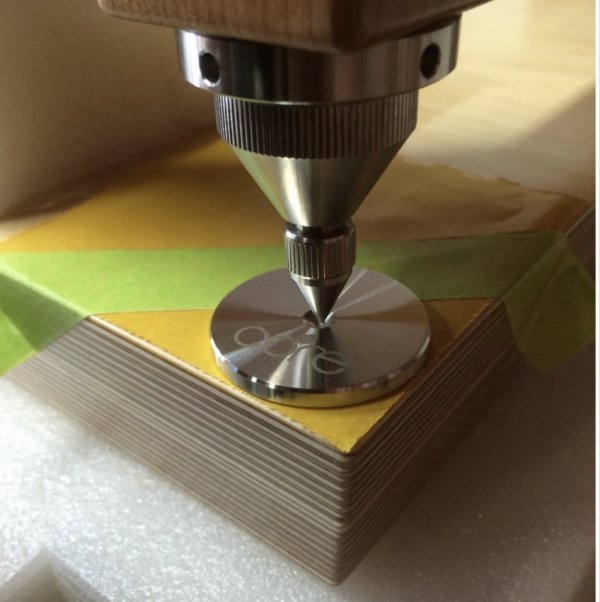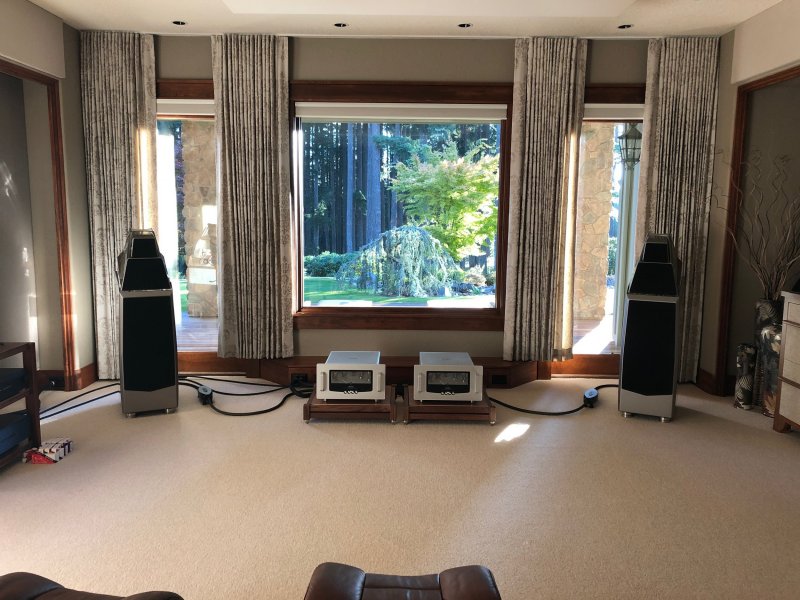the effect of the Panzerholtz remains as long as the amps are sitting directly on the Tana units. I think the wood is there to address the higher vibration frequencies not addressed by the active piezo electronics. The two tegether (in active mode) seem to make for more widespread isolation. Turning the unit on or off, active or passive, affects tuning. Is that right Mike?Yes you did answer my question, thank you.
You said you could turn on and off the coupling of your amp and Tana Herzan. By your explanation I understand you can activate or deactivate the Herzan piezo electric counter vibration function (or however you want to describe it.) To me 'coupling' means the joining of two objects, eg sitting on on top of another.
Ron's Speaker, Turntable, Power and Room Treatment Upgrades
- Thread starter Ron Resnick
- Start date
You are using an out of date browser. It may not display this or other websites correctly.
You should upgrade or use an alternative browser.
You should upgrade or use an alternative browser.
the 10mm panzerholtz layer attached to the Herzan aluminum top plate has a function. the thin rubber membrane has a function. the Daiza sitting on top of the membrane has a function. the foam inserts inside the Daiza have a function. all together they do provide higher frequency resonance attenuation. it's an engineered solution.the effect of the Panzerholtz remains as long as the amps are sitting directly on the Tana units. I think the wood is there to address the higher vibration frequencies not addressed by the active piezo electronics. The two together (in active mode) seem to make for more widespread isolation. Turning the unit on or off, active or passive, affects tuning. Is that right Mike?
i do not view turning the active unit off as tuning, but sure......i guess it is in a way. the performance is different (diminished).
i view turning the active off as lowering the musical equation. might some prefer it? not yet occured in my system experiences.
Last edited:
The Herbies that I got were small dimpled metal disks glued to the closed cell foam layer of a furniture slider, if I might so crudely describe them. I did not spend any mental cycles trying to understand how they “killed the music” but it is as clear a description as I can muster. Simply put, my system played all the sounds, technically the music was playing, but I (and my wife) heard no music. Something was very obviously wrong. I first listened then asked my wife to listen. With no prompting from me she said “what changed, that doesn’t sound right.” There was no emotional connection, no “flow” like watching American Idol where a young singer sings the song correctly but has no emotional connection or understanding of the lyrics. You listen and think “meh.”I just don't understand how those footers could have such a big sonic effect. Is the theory that the footers decoupled the amplifiers from the floor (they literally are named "de-couplers") and thus A) prevented energy from draining out of the component and into the floor, or B) allowed airborne or floor-borne vibration to leech into the component, or C) both?
What do you mean, the sound was there, but not the music?
In what way did the footers kill the music?
What are your amplifiers sitting on now?
My ARC Ref160s sit on Core Audio Furniture platforms (spiked to the floor, through the carpet) with StillPoints Ultras replacing the ARC rubbery footers.
Would love to give the Centerstage footers a try, but having caught the attention of the Minister of Finance with this years upgrades to my analog rig, I am on hiatus at least until I do some more amazing landscape work and she feels guilty.
Ron, you like Tang's current sound, yes? Yes.
Well, he has his Lamm monos about as inoppurtunely situated as you can imagine, by being plonked on his Cessaro basshorns.
Maybe that scenario alone should mean you have no reservations just starting w your power amps w stock footers on the floor. And if needed, move on from there.
Well, he has his Lamm monos about as inoppurtunely situated as you can imagine, by being plonked on his Cessaro basshorns.
Maybe that scenario alone should mean you have no reservations just starting w your power amps w stock footers on the floor. And if needed, move on from there.
The Herbies that I got were small dimpled metal disks glued to the closed cell foam layer of a furniture slider, if I might so crudely describe them. I did not spend any mental cycles trying to understand how they “killed the music” but it is as clear a description as I can muster. Simply put, my system played all the sounds, technically the music was playing, but I (and my wife) heard no music. Something was very obviously wrong. I first listened then asked my wife to listen. With no prompting from me she said “what changed, that doesn’t sound right.” There was no emotional connection, no “flow” like watching American Idol where a young singer sings the song correctly but has no emotional connection or understanding of the lyrics. You listen and think “meh.”
My ARC Ref160s sit on Core Audio Furniture platforms (spiked to the floor, through the carpet) with StillPoints Ultras replacing the ARC rubbery footers.
Would love to give the Centerstage footers a try, but having caught the attention of the Minister of Finance with this years upgrades to my analog rig, I am on hiatus at least until I do some more amazing landscape work and she feels guilty.
Thank you, Bob.
Those Core Furniture products look great! I don't know how the amp stands would sound, but in natural walnut they would match my floor and walls!

I could just attach self-stick felt sliders on the underside of the Core Furniture flat metal feet and slide the amps around.

Last edited:
Ron, you like Tang's current sound, yes? Yes.
Well, he has his Lamm monos about as inoppurtunely situated as you can imagine, by being plonked on his Cessaro basshorns.
Maybe that scenario alone should mean you have no reservations just starting w your power amps w stock footers on the floor. And if needed, move on from there.
I have never heard Tang's system in person, unfortunately.
The proof is in the pudding (implementation and sonic result trumps theory) and Tang's system seems amazing! But, yes, in theory, I would think the top of the basshorn is not the ideal location for tube electronics.
The stock footers are spikes. These can be removed. But I still have to be able to slide the amps around, at least for the first few months. Do I use simple furniture sliders for this?
I think you give me good advice.
Step 1...Situate amps w stock spikes in position A.
Step 2...When ready to move them, install sliders. Move to position B.
Step 3...Remove sliders.
Step 4...Repeat Steps 1 to 3, inserting positions C, D, E etc as needed, and possible return to positions A, and/or B.
Step 5...when final position chosen, then consider experimenting w after market footers, ampstands etc.
Step 2...When ready to move them, install sliders. Move to position B.
Step 3...Remove sliders.
Step 4...Repeat Steps 1 to 3, inserting positions C, D, E etc as needed, and possible return to positions A, and/or B.
Step 5...when final position chosen, then consider experimenting w after market footers, ampstands etc.
I like Core Audio products for their aesthetic and value. I don’t have the resources or patience to buy and try a bunch of different stands to see which optimizes the last degree of sound. I am sure many would disagree but if the footers I choose are doing their job the stands should be less consequential. Priorities and resources. But everything matters, so I speak for myself only.Thank you, Bob.
Those Core Furniture products look great! I don't know how the amp stands would sound but in natural walnut they would match my floor and walls!
I do like the look of the stands in my room...

Step 1...Situate amps w stock spikes in position A.
Step 2...When ready to move them, install sliders. Move to position B.
Step 3...Remove sliders.
Step 4...Repeat Steps 1 to 3, inserting positions C, D, E etc as needed, and possible return to positions A, and/or B.
Step 5...when final position chosen, then consider experimenting w after market footers, ampstands etc.
Thank you, but each amp weighs 91 kilograms/200 pounds. Switching spikes and gliders repeatedly is not practical. Also I do not want to pock mark the walnut floor. This is why I want to start with rubber wheels or felt gliders.
Although we do not have enough technical details to know how the system really operates I think that when the active system is turned off you just have a passive platform sitting on the top of an undamped system. IMHO we can not separate the notion of coupling from frequency - the active system couples at some frequencies and completely decouples at the intended isolation frequencies.Yes you did answer my question, thank you.
You said you could turn on and off the coupling of your amp and Tana Herzan. By your explanation I understand you can activate or deactivate the Herzan piezo electric counter vibration function (or however you want to describe it.) To me 'coupling' means the joining of two objects, eg sitting on on top of another.
IMHO listening with the active system turned off should sound very different from sitting the amplifiers on the floor.
Soon I will post pics of my new turntable, it’s turned out to be pretty special. When my buddy say it he said “how’d you get through the war department?”The Herbies that I got were small dimpled metal disks glued to the closed cell foam layer of a furniture slider, if I might so crudely describe them. I did not spend any mental cycles trying to understand how they “killed the music” but it is as clear a description as I can muster. Simply put, my system played all the sounds, technically the music was playing, but I (and my wife) heard no music. Something was very obviously wrong. I first listened then asked my wife to listen. With no prompting from me she said “what changed, that doesn’t sound right.” There was no emotional connection, no “flow” like watching American Idol where a young singer sings the song correctly but has no emotional connection or understanding of the lyrics. You listen and think “meh.”
My ARC Ref160s sit on Core Audio Furniture platforms (spiked to the floor, through the carpet) with StillPoints Ultras replacing the ARC rubbery footers.
Would love to give the Centerstage footers a try, but having caught the attention of the Minister of Finance with this years upgrades to my analog rig, I am on hiatus at least until I do some more amazing landscape work and she feels guilty.
to respond to your point, when we compared the floor to switching the active off but still on the Tana, there was little difference, very slightly in favor of the Tana in off position.Although we do not have enough technical details to know how the system really operates I think that when the active system is turned off you just have a passive platform sitting on the top of an undamped system. IMHO we can not separate the notion of coupling from frequency - the active system couples at some frequencies and completely decouples at the intended isolation frequencies.
IMHO listening with the active system turned off should sound very different from sitting the amplifiers on the floor.
with extended listening maybe more differences might have immerged, but that was not practical.
my amps are particularly well built, and have an internal suspension, so likely that comes into play here. i agree that everything matters, but maybe is not audible enough to be known.
We should certainly add SRA and probably a couple more to this group of higher end manufacturers. The point I was making goes beyond footers and platforms of one manufacturer inside another brand's rack, it's the mixing of these brands in any capacity in a high resolution system. I.e., a Nothing Rack for components and amp stands from one of these brands or vice versa. In a properly set up high resolution system you'll hear a duality or discontinuity when combining products from any of these particular brands with a Nothing Rack or Nothing Platform. The Nothing Racks and platforms have a fundamentally different approach than the mentioned brands. If quality of sound is the final product, they're distinctly different products specially when it comes to the quality of bass and low bass. That's where you'll the most significant separation among the brands.I agree. And generally few manufacturers find a different product of similar purpose completes theirs. Often the two products are not complimentary and may work at cross purposes, as you mentioned earlier. Buy a Nothing rack or an XYZ rack then put a component on it using Stillpoints .... people do that sort of thing - go figure.
I currently have in for review an SRA platform built for my turntable. It is sitting on the top shelf of an SRA Scuttle rack that I bought several years ago. So, two different vibration management products together. However, SRA knows I own a specific model Scuttle and factored that into the custom build of the turntable platform. That likely would not happen with two different manufacturers or with off-the-shelf products.
david
I suspect there's not "nothing" to them.David, what is a “Nothing Platform”?
to respond to your point, when we compared the floor to switching the active off but still on the Tana, there was little difference, very slightly in favor of the Tana in off position.
with extended listening maybe more differences might have immerged, but that was not practical.
my amps are particularly well built, and have an internal suspension, so likely that comes into play here. i agree that everything matters, but maybe is not audible enough to be known.
I think that the important point, as referred by Tim, is the type of floor being used in the room and most of it the building technique and details around it. Without them we are just speculating and unfortunately I do not remember how Ron's listening room floor was built.
The same way people use Roon and microphones to study the listening room acoustics we can use Roon and an accelerometer to study walls, ceiling and floor vibration - I played a bit with it some years ago when tuning basstraps, but unfortunately I had to return the accelerometer to its owner.
Something similar to being "neutral". Most people claim to be neutral, but they all sound very different.I suspect there's not "nothing" to them.
Simple answer, no. I don't see the purpose of a rack as changing the sound and resonant nature of equipment which is exactly what footers do. It's called Nothing Rack because it doesn't add, alter, divert nor take away resonant energy to or from equipment which we know will alter the sound of equipment, that's not the purpose of Nothing Racks. Nothing racks are engineered to isolate equipment from the floor using mass and a physical decoupling structure in the feet and isolating the shelves from the structure and one another to avoid interaction between equipment. There's only minimal dampening in the upper shelf to dissipate some of the vibration from the turntable motor but nowhere else in the structure. There's now a 2nd level of detached material placed on top of the shelves to further isolate the equipment resonance from that of the shelves. Up to this point I haven't haven't heard a method of dissipating or altering resonance without affecting the sound in some major way so I decided to leave it alone with our design.Does the "The Nothing Rack" comes mit dedicated footers between component chassis and rack platform?
or are the standard component feets the unknown variable in the concept?
( I have not seen this Rack in life, so I do not know)
david
Last edited:
It's a single level stand to isolate electronics from the floor with the same engineered structure as the Nothing Rack.David, what is a “Nothing Platform”?
david
Last edited:
It's a single level stand to isolate electronics from the floor with the same engineered structure as the Nothing Rack.
david
Thank you David. Sounds like Ron’s solution.
Similar threads
- Replies
- 17
- Views
- 1K
- Replies
- 3
- Views
- 276
- Replies
- 3
- Views
- 434
- Replies
- 3
- Views
- 857
| Steve Williams Site Founder | Site Owner | Administrator | Ron Resnick Site Owner | Administrator | Julian (The Fixer) Website Build | Marketing Managersing |

